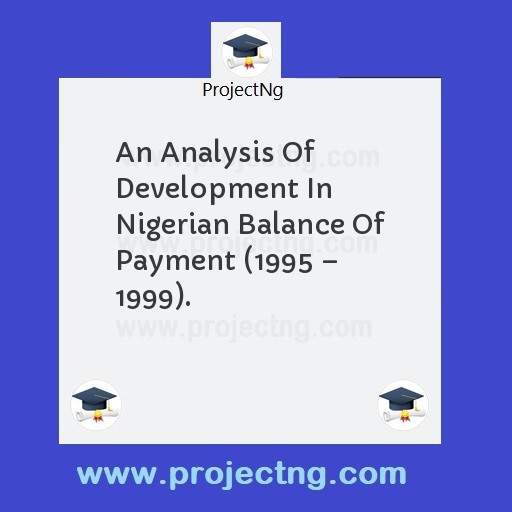An Analysis Of Development In Nigerian Balance Of Payment (1995 – 1999).
Accounting Project Topics
Get the Complete Project Materials Now! »
AN ANALYSIS OF DEVELOPMENT IN NIGERIAN BALANCE OF PAYMENT (1995 – 1999).
ABSTRACT
This study, an analysis of development in Nigerian balance of payment (1995 – 1999) was carried out to assertion whether Nigeria has been paying her wages internationally to examine the statement with a view to determine what recent developments have taken place in Nigerians foreign trade and others transaction with the rest of the world.
Information was collected using literary method i.e. various publications, textbooks newspapers, magazines and journals. Also, oral interviews were used to elicit information from some government officials (staff).
It was found out that the exports receipts were sufficient to pay for the imports and settle some international obligations that fell due within the period, the fact remains that the managers of the economy did not exercise a considerable amount of control over the foreign exchange resources.
It was however, recommended that if not for the debt management strategies pursued by government during that period, there would have been more years deficits in the balance of payment position over and above four years recommended.
CHAPTER ONE
1.0 INTRODUCTION
In an era when advancements in travel and communication technology have reduced the whole world to what may at best be described as a global village and the barriers that had hither to separated one country from the other appear to have been reduced to the bearest minimum, economic relationships can be established with little or no difficulty amongst nations.
Consequently, there is a continuos flow of resources across boarders. The continuity which characterizes the flow of resources makes reckoning imperative balance of payment statement is the means through which the reckoning is performed ad it is a summary of a country’s international transaction.
The major components of that activity are the trade balance (Merchandise exports minus merchandise imports), the current account balance (trade, services and transfer) and the capital accounts balance. The net total of these balances must equal zero, since the quantity of naira paid must equal the quantity received. It can also be deduced that the number of possible “balances” in the balance of payment is equal to the number of possible groupings of accounts in that statement. Balance computed on the basis of certain accounts in the balance of payments provide an indication of how given economic sectors contribute to the economic position of the country in international market.
For instance, an analysis of a surplus in the merchandise trade account can show the contribution that net export of goods from that country make to the country’s acquisition of external purchasing power. However, the most common reason for computing “a balance” in the balance of payment is to understand the net market pressures that affect the international value and availability of the currency between (1995 – 1999).
Finally, the balance of payment figures report the amount of international flows on a historical basis, after the fact.
Thus, when we include the reserves accounts, the supply of exchange equals the demand for exchange, just as "“debits equal credit" if we want to use the balance of payment as a tool to measure the pressures in the exchange market; we must look to the future. It is only this sense that we can see imbalance between supply and demand for foreign exchange developing at the going exchange rates. Governments may choose to provide the funds needed to establish balance at the going exchange rate or alternatively, they may let the exchange rate fluctuate to bring the forces of supply and demand into balance. International monetary agreements adjusting imbalances in international flow.
1.1 BACKGROUND OF THE STUDY
The background of this study is to analyze the recent trends in Nigeria balance of payment with a view to determining whether the country was able to pay her way internationally within periods of 1995 – 1999 and to determine whether the monetary and exchange rate policies pursued were effective.
To carryout this study work the main data will be carried out through primary data source, interviewing with Central bank of Nigeria (CBN) and top ranking officials while the secondary data will be collected from an extensive research in CBN as well as other libraries, books, journals and other publications. Further deductive logic will be used to arrive at certain conclusion.
1.2 STATEMENT OF PROBLEM
Considering the importance of balance of payments, statement as a source of information for the managers of the Nigerian economy and indeed other interested users of the balance of payment statement, these is a compelling need to constantly analyze the statement with the view of determining:
1. Whether the nation is paying her wages internationally in other words, is the nation paying for goods, drawing down her foreign reserves accumulating foreign liabilities or through the receipt of gifts and donations.
2. Is the country borrowing or lending money to the international community?
3. How effective are the various policy initiatives I checking international payments imbalances?
These problems are what this project is out to investigate.
1.3 OBJECTIVES OF STUDY
With due reference to the questions raised on the proceeding section, this researchers intends to collect, collate and analyze data on Nigerian
Be the First to Share On Social

Enjoying our content?
Don't miss out on new videos! Subscribe to our YouTube channel for more awesome content.
Subscribe Now!













